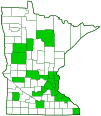three-lined potato beetle
(Lema daturaphila)
Conservation • Description • Habitat • Ecology • Distribution • Taxonomy
|
|
||||||||||||||
Description |
Three-lined potato beetle is a small leaf beetle. It occurs in Central America, South Africa, eastern Australia, and nearly throughout North America. It is sometimes an agricultural pest on potato and tomatillo crops. Adults are ¼″ to 5 ⁄16″ (5.7 to 8.0 mm) long and brightly colored. They are oval when viewed from above, about 1½″ times longer than wide, and convex when viewed from the side. The conspicuous coloration is probably a warning of their distastefulness to predators. The head is usually entirely orange. Rarely, there is a black patch between the eyes. The head is prominent, not partially covered by the hardened plate on the upper side of the thorax (pronotum). There is a deep, somewhat X-shaped grove on the front of the head, but this is visible only when the head is directed forward. The plate above the upper lip (clypeus) is fused to the upper part of the face (frons), and there is no visible line distinguishing one from the other. The eyes are black and are not notched. The antennae are mostly black; are short, less than half as long as the body; and are widely separated at the base. They are weakly clubbed (clavate), gradually enlarged as they approach the tip. The pronotum is rectangular, strongly constricted in the middle, slightly rounded in front, and slightly wider than long. It does not have a flattened lateral margin. It is broader than the head, and much narrower than the base of the hardened forewings (elytra). It is orange and has a pair of conspicuous black spots. The spots are round and variable in size, sometimes smaller or missing, sometimes a little larger, rarely much expanded and coalescing into a single patch. The elytra are long and cover the tip of the abdomen. They are rounded at the shoulders, parallel on the sides, slightly widened toward the rear, and broadly rounded at the tip. They are hairless, shiny, and orangish-yellow or yellow. Each elytron has a black stripe on the inner margin and a black longitudinal stripe just above the lateral margin on each side. They also have 10 rows of clearly aligned, moderately sized pits (punctures). The ninth row is complete. The space between two rows of punctures (interval) is smooth or slightly wrinkled and has small punctures. The lateral black stripes are usually 3 or 4 intervals in width. The plate at the base of the elytra (scutellum) is black, triangular, and very small. The third and largest segment of each leg (femur) is entirely orange. The fourth segment (tibia) orange just at the base, then black for at least half of the segment’s length. The tibiae on the hind leg has 1 or 2 spurs at the tip. The last part of each leg (tarsus), corresponding to the foot, has five segments. All segment are entirely black. The third segment is broadened and has two lobes at the tip, appearing heart-shaped. The fourth segment is extremely small and is concealed between the lobes of the third segment, making it appear that there are only four segments. Each tarsus ends with a claw. The claws touch at the base for one-third to one-half of their length. The larvae are black and look like caterpillars, but have six legs on the thorax and no prolegs on the abdomen. Larvae are yellow and 3 ⁄16″ to ¼″ long. |
Size |
Total length: ¼″ to 5 ⁄16″ (5.7 to 8.0 mm) |
Similar Species |
Habitat |
|
Ecology |
Season |
Two generations per year. May to August. |
Behavior |
The plants that three-lined potato beetle larvae feed on contain tropane alkaloids or glycoalkaloids which provide a defense against insects. However, the larvae cannot sequester the chemicals for their own protection. Instead, they cover their bodies with their own feces, making them unpalatable to predators. When first exuded, the frass is a frothy mass that looks like saliva. It turns brown as it dries. Adults chew irregular holes in leaves. |
Life Cycle |
The female lays a cluster of 2 to 21 but usually just 8 eggs on the leaf of a host plant. She does this every day for up to 68 days, eventually laying 290 to 2,715 eggs. The eggs hatch in 3 to 5 days. The larva feed openly for 5 to 20 days, then drop to the ground and pupate in the soil or beneath litter on the ground. Adults emerge 7 to 17 days later. Young adults overwinter in litter on the ground. Some pupa also overwinter. |
Larva Food |
Same as adults |
Adult Food |
Leaves of plants in the Solanaceae (nightshade) family, especially those in the Datura, Physalis, Atropa, Nicandra, and Salpichroa genera. |
Distribution |
||
|
Sources |
|
| 8/19/2024 | ||
Occurrence |
||
Common and widely distributed |
||
Taxonomy |
|
Order |
Coleoptera (Beetles) |
Suborder |
Polyphaga (Water, Rove, Scarab, Long-horned, Leaf, and Snout Beetles) |
Infraorder |
Cucujiformia |
Superfamily |
Chrysomeloidea (leaf beetles and allies) |
Family |
Chrysomelidae (leaf beetles) |
Subfamily |
Criocerinae (shining leaf beetles) |
Tribe |
Lemini |
Genus |
Lema |
Subgenus |
Quasilema |
This species was formerly classified as Lema trilineata. That scientific name conflicted with another species, and the was changed to Lema daturaphila in 1970. The species epithet daturaphila means “Datura love”. Datura is the genus of plants that includes jimsonweed, one of many plants in the Solanaceae (potato) family that serves as a host for the larvae. |
|
Subordinate Taxa |
|
|
|
Synonyms |
|
Lema trilineata Lema trilineata trilineata Lema trilineata daturaphila Lema trilinea |
|
Common Names |
|
three-lined potato beetle |
|
Glossary
Clypeus
On insects, a hardened plate on the face above the upper lip (labrum).
Elytra
The hardened or leathery forewings of beetles used to protect the fragile hindwings, which are used for flying. Singular: elytron.
Femur
On insects and arachnids, the third, largest, most robust segment of the leg, coming immediately before the tibia. On humans, the thigh bone.
Frons
The upper front part of an insect’s face, roughly corresponding to the forehead.
Pronotum
The exoskeletal plate on the upper side of the first segment of the thorax of an insect.
Scutellum
The exoskeletal plate covering the rearward (posterior) part of the middle segment of the thorax in some insects. In Coleoptera, Hemiptera, and Homoptera, the dorsal, often triangular plate behind the pronotum and between the bases of the front wings. In Diptera, the exoskeletal plate between the abdomen and the thorax.
Tarsus
On insects, the last two to five subdivisions of the leg, attached to the tibia; the foot. On spiders, the last segment of the leg. Plural: tarsi.
Tibia
The fourth segment of an insect leg, after the femur and before the tarsus (foot). The fifth segment of a spider leg or palp. Plural: tibiae.
Visitor Photos |
||
Share your photo of this insect. |
||
This button not working for you? |
||
Alfredo Colon |
||
 |
||
 |
 |
|
 |
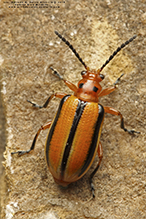 |
|
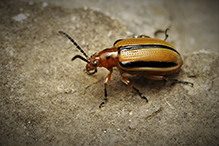 |
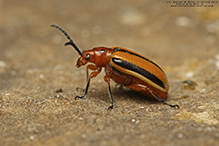 |
|
Teresa Fogarty |
||
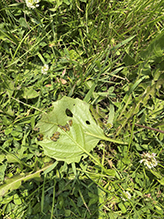 |
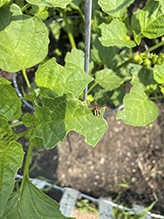 |
|
Three stripe potato bug in Cologne MN on the tomatillo plants. What’s next?? |
||
Mike Poeppe |
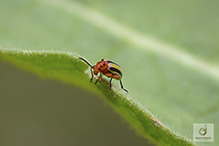 |
MinnesotaSeasons.com Photos |
||
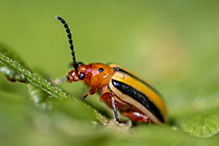 |
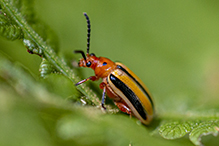 |
|
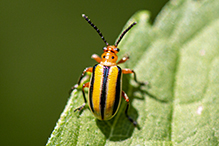 |
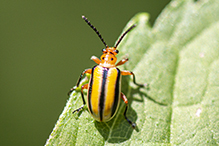 |

Slideshows |
|

Visitor Videos |
||
Share your video of this insect. |
||
This button not working for you? |
||
|
Other Videos |
||
|

Visitor Sightings |
||
Report a sighting of this insect. |
||
This button not working for you? |
||
Alfredo Colon |
Location: Albany, NY |
 |
Alfredo Colon |
Location: Albany, NY |
 |
| Teresa Fogarty 6/16/2023 |
Location: Cologne, MN on the tomatillo plants. What’s next?? |
 |
| Mike Poeppe 6/24/2022 |
Location: just west of Houston, MN |
 |
| Alfredo Colon 8/12/2019 |
Location: Woodbury, Minnesota |
 |
MinnesotaSeasons.com Sightings |
||
Burnsville, MN |

Created: 12/3/2019 Last Updated: © MinnesotaSeasons.com. All rights reserved. |
